Sprint HTC Evo 4G Review
Picture, if you will, your perfect smartphone. What features would it have? How small (or big) would it be? Would it have what it takes to get you off that BlackBerry, or iPhone, or whatever.
Sprint and HTC have done that -- and then some -- with the Evo 4G. It's the world's first Android smartphone that can use Sprint's 4G WiMax data. It has a monstrous 4.3-inch touchscreen. It has the ubiquitous 1GHz Snapdragon processor. It has the HTC Sense interface, to make your experience as easy as possible.
But that's all nerdspeak. Know this: It's big, it's fast, it's easy to use, and it's just about the best Android smartphone available today. And it is available Friday (finally!) for $199 after contract and rebate with Sprint. We explain why you'll want this one, after the break.
The links
Evo 4G hardware hands-on video | Software walkthrough video
Under the hood | Battery life | Storage card | 4G WiMax data | Camera test | Video chat |
WiFi hotspot | TV-out | On-screen keyboard | Etcetera | Conclusion
The hardware (meaning, that giant screen)
Let's start with the obvious -- the Evo 4G is a large phone. (Find the complete technical specs here.) It's probably bigger than anything you've used, in fact. Larger than an iPhone. It completely covers a Palm Pre. The BlackBerry Storm and HTC Touch Pro 2 have a chance, but only a chance. The Evo dwarfs them all.
Get the top Black Friday deals right in your inbox: Sign up now!
Receive the hottest deals and product recommendations alongside the biggest tech news from the Android Central team straight to your inbox!
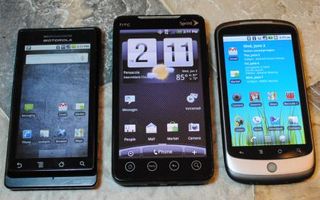
(From left: Motorola Droid, HTC Evo 4G, Google Nexus One)
Just how big is the Evo? Measuring in at 4.8 inches tall, 2.6 inches wide and a half-inch thick (or thin, actually), the Evo has a sizable footprint. By comparison, the iPhone 3G is just a tad more narrow and about a third of an inch shorter -- and the diagonal measurement of the screen is a mere 3.5 inches, or nearly an inch less than the Evo.
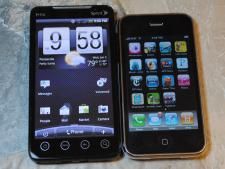
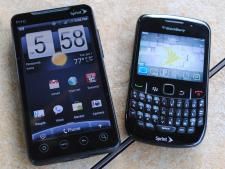
(Sprint Evo 4G with the iPhone and a BlackBerry Curve Curve 8530)
The Evo is the epitome of the "black slab" phone. The front face is dominated by the screen (we've mentioned how big it is, right?). The four buttons at the bottom (in the home-menu-back-search configuration) are capacitive, meaning there are no moving parts, nothing to actually press (same as on the Motorola Droid). But that's been a cause of concern for some, as the capacitive buttons on the Nexus One (another HTC device) have had accuracy issues. We're happy to report we've had no such issues with the Evo's buttons. You get what you tap.
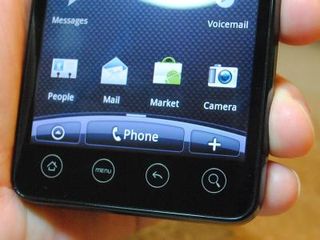
(Buttons on the face of the Evo 4G are capacitive and don't physically move)
The touchscreen itself is very accurate as well. (See our multitouch test.) It's a TFT LCD -- same as the current iPhone and a number of other smartphones -- in lieu of the newer OLED (organic light-emitting diode) and AMOLED (active matrix OLED) screens. If you're the type of person who lives and dies by specs and counts pixels for fun, you'll probably be able to tell the difference. Otherwise, you're just going to be floored by the sheer size of this screen and won't miss any extra contrast or clarity. (And besides, not everybody's sold on AMOLED screens yet anyway.) There's a tad of light leakage at the bottom, where the screen panel meets the bezel. Chances are you'd never notice if it weren't pointed out to you. You can thank us later.
At the top of the screen you have the earpiece speaker, which is sizable in that it stretches for just about half the width of the phone while remaining consistent with the clean design of the Evo. Just above the "p" and "r" in the Sprint logo is a little 1.3-megapixel camera. That's right, a front-facing camera. That's a first for a U.S. smartphone. (Edit: Silly us, forgot about Nokia. Imagine that ... Forgetting about Nokia in the U.S.)
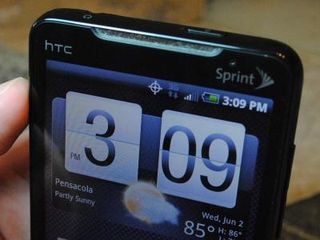
(Front-facing camera and ear speaker)
The top bezel of the Evo houses the 3.5mm headphone jack for listening to music, as well as the power button. The volume rocker is on the right-hand bezel. The bottom bezel has the microphone hole (looks like a little pinhole), the microUSB port and a microHDMI port for connecting the phone to a high-definition television.
It's not often that we give much thought to the rear of a phone, save to say that there's a camera and maybe a flash there. And both are on the Evo. (In fact, the 8-megapixel camera on the Evo has dual flashes.)
The back of the Evo also sports a kickstand for propping up the phone horizontally (aka "landscape" mode) for watching videos and photo slide shows. The kickstand is easy to extend, and it's spring loaded so that it stays put when you don't want it. It's just another one of those little details that manufacturer HTC does so well to get right. (Another plus for the kickstand: It keeps the camera lens cover well away from anything that could scratch it.)
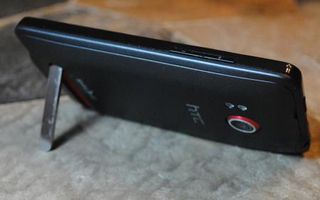
(Multimedia kickstand on the Evo 4G)
If you don't watch movies on your phone on a regular basis, we don't blame you. But that was before you had the Evo 4G. (And here's where we gush about the screen size again.) Don't worry about that kickstand, though, if you're not going to use it. It's completely out of the way and doesn't fall out on its own.
Included in the box with the Evo 4G are a basic USB wall charger and microUSB cable. You could actually go the entire life of your Android phone without connecting it to a computer. But if you need to, microUSB is the cable you do it with. It's a bit disappointing that Sprint didn't include a microHDMI cable with the phone for TV out, given that it's a big talking point for the Evo and not a cable that most people will already have on hand.
What's under the hood
A big smartphone needs a big processor, and the Evo has the top-of-the-line Qualcomm Snapdragon processor (we're even seeing it mentioned by name in commercials these days) running at 1GHz. [See the Evo 4G benchmarked against the Nexus One with Android 2.2]
Launching with Android 2.1
The Evo is launching with Android 2.1 (that's the version known as "Eclair") and has the HTC Sense user interface on top of it. We've proven that you can turn off the stock Sense launcher (affectionately named "Rosie," if you must know), but that's not something we recommend. This is a Sense device (same as the HTC Legend [review] and Droid Incredible [review] on Verizon). It was meant to be a Sense device.
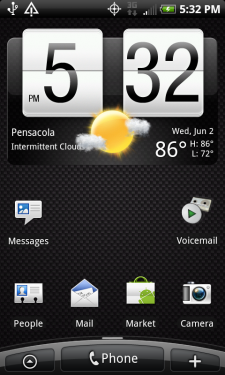
If you're new to Android, Sense is a wonderful way to get acclimated, and the version on the Evo 4G is the same as we've seen on the Legend and Droid Incredible. Check out our Sense review and videos for the full skinny. But the bottom line is this: The pre-installed widgets and little tweaks HTC has made make Android as easy to use as ever.
 Waiting on Android 2.2 Froyo
Waiting on Android 2.2 Froyo
Speaking of the operating system, you've undoubtedly read a lot about the latest version of Android -- Version 2.2, or Froyo. [See our complete Froyo feature breakdown and software walkthrough] The Evo's not launching with Froyo, and that's a shame, as we really like what we've seen, especially when it comes to some behind-the-scenes tweaks. (Again, for you spec nerds: Once the Evo has Froyo and the JIT running the show, this thing's gonna scream.) It's really just bad timing that the Evo won't have Froyo at first. We don't have an official date for when the Evo may be upgraded, but we're absolutely expecting it to get Froyo.
For the hackers: We now have root
For those of you who just can't leave well enough along and want to root the Evo 4G, it can be done, and it's very easy. Follow our instructions here. [Why would you want to root? Read this.]
Battery life: Not great, but not a deal-breaker
The Evo comes with a 1500mAh battery. Turns out it's physically similar to the batteries used in the HTC Hero, Droid Incredible, Droid Eris and Touch Pro 2. So if you have any of those older devices laying around, you can keep the batteries as spares. And you may well need to do so. A 1500mAh battery is a decent size, but the Evo needs its share of juice. For many, getting through a day on a single charge may be just fine. But power users likely are going to need to plug in, or carry an extra battery. That's definitely not a deal-breaker for the Evo, it's just something to be aware of.
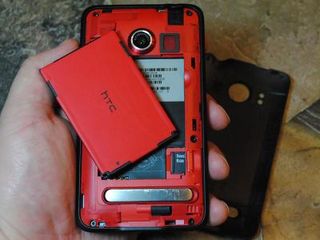
(Hope you like fire-engine red)
Here's our thing about batteries: They're meant to be used. You can turn down the screen brightness, turn off 3G, 4G, WiFi and Bluetooth. You can avoid playing videos, music -- whatever. But then you're not really using the phone, are you. As smartphones get better and better, we use them more in our daily lives. It'd be great if battery technology was keeping up. But it's not, and so you might actually have to plug in your phone during the day. It's OK. It's not an attack on your smartphone manhood (or whatever the female equivalent is). Go ahead. Charge your phone.
The microSD storage card
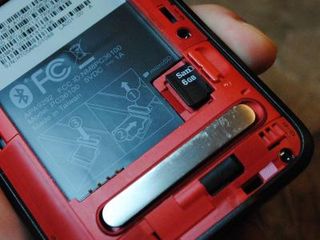
(The microSD card is tucked under the battery)
Underneath the battery is where you'll find the Evo's microSD card slot. If you're the type who's used to swapping cards on the fly, you're going to have to get over that. First, you have to remove the battery, and means turning off the phone. And then there's the matter of actually removing the card. There's a small tab that you pry up to unseat the card. That part's easy. But actually removing the card can be a bit tricky if you don't have long fingernails (and forget about it if you have no fingernails). Keeping tweezers around will help.
The Evo 4G's standout features
On one hand, the Evo 4G is just another black-slab smartphone. A high-end one, to be sure, but a black-slab nonetheless. There's nothing decidedly revolutionary here, huge screen, 4G data or not. But it really is the sum of the parts that puts the Evo at the top of the heap. First and foremost is the screen, of course, which we've already gushed about (but reserve the right to do some more). The screen is the single-most part of the phone with which you'll interact, so it gets top billing. But the list goes on.
Sprint 4G WiMax data

The Evo 4G is being billed as "the world's first 3G/4G handset," and it is. It uses Sprint's traditional 3G data (which is pretty darn good most of the time) and also uses fledgling 4G WiMax data. Sprint's line is that 4G data is 10 times faster than 3G data. And theoretically, that's true. But you're not going to get theoretical speeds. That's not to say 4G speeds aren't significantly faster than 3G speeds -- because they are, and if we had to choose one, we'd choose 4G. But the WiMax network is still young and availability is limited to major metro areas at this point (and even then, not necessarily the nation's largest).
Add to that the fact that we're seeing mixed reports of WiMax speeds from different markets. Some think it's great, others are seeing faster 3G speeds. Could be the network, could be environmental or geological factors.
As far as actually using the 4G capability of the Evo 4G? It's as simple as flipping a switch. Sprint has included a widget to turn 4G on and off, and you can also get to it through the wireless and network settings.
A lot also has been made of the $10 monthly fee that comes on top of your Sprint plan. It's been incorrectly labeled a "4G tax," as it also covers other "premium services" on the Evo 4G, says Sprint, and you'll be paying it even if you don't live in a 4G area. We can't be everywhere at once, and we'll be looking more at 4G data speeds once the Evo is in your hands. But for the moment, we'll consider 4G data to not be a deciding factor on the Evo. It's a pretty major feature, but you'll enjoy the phone just fine even if you don't live in a town with 4G.
The Evo 4G camera(s)
Let's start with the big daddy. The Evo 4G's main shooter is an 8-megapixel autofocus lens on the rear of the phone. It takes pictures with a minimum resolution of 640 pixels by 384 pixels, and at its full resolution fires off at 3264x1952. It's augmented by a pair of LED flashes.
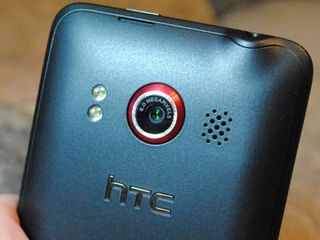
(An 8-megapixel camera with dual flashes)
Pictures from the 8MP camera are above average for a smartphone. Colors stand out well in full sunlight, and for the most part you should be pleased by the results. But the increase in megapixels doesn't mean you'll be throwing away your DSLR anytime soon. You can probably leave your point-and-shoot at home. But what you get with the 8MP camera here is larger pictures (and larger file sizes) -- not larger and clearer images. You can digitally zoom and crop, but you'll immediately know you're working with a cell phone camera, albeit a very good one.








In addition to being the first phone with 4G data, the Evo 4G also is the first U.S.-based phone to have a front-facing camera. Yes, there's a small 1.3-megapixel shooter on the front of the phone, and it's surprisingly good. The primary function of the front-facing camera is for video chats (more on that in a bit), but it's also good for taking goofy self-portraits. You'll have to take care, however, to not cover the pinhole lens with your left hand when you're holding the Evo in front of you -- it's real easy to do. By the way: The front camera shoots in reverse. Just so you know.

(Testing the front-facing camera)
Video quality was just OK, despite all of the brouhaha over being able to shoot in 720p. Again, we're talking increased image resolution and not increased image clarity. We'd prefer quality over size at this point. But that will understandably drive up the cost of a phone. It's just one of those trade-offs. Still, for smartphone video, it's not horrible. But you also won't want to throw out that dedicated video camera just yet.
Evo 4G rear camera video test at 720p
Evo 4G front-facing camera video test
Video chat
Sprint invited us media types up to New York City for an Evo launch party, and one of the major new features we got to see was video chat, taking advantage of that front-facing camera. Qik -- one of the first live-streaming video apps to come to market on other platforms -- is on the Evo 4G, and it worked pretty well. For a brief time there were rumors that basic video chat via Qik would cost extra, but that turned out to not be true.
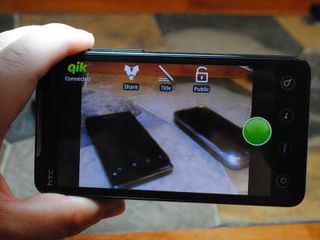
(Quick Qik test on the Evo 4G)
But Qik quickly (erm, sorry) has found front-facing competition (erm, sorry again) in the likes of Fring, which already has updated to support the Evo 4G and its dual cameras. And even better is that it ties into other VOIP apps, meaning you can use Fring on your phone to video chat with somebody using Skype on a desktop. And speaking of Skype, it's promising video chat later this year, too. All of this early competition is bound to be good for the users, and it's likely we'll continue to see free solutions crop up.
WiFi hotspot - the $29 add-on
Another major selling point (at least as far as Sprint's concerned) for the Evo 4G is the ability to serve as a WiFi hotspot for as many as eight devices. The basic premise is this: The phone sucks in the regular cell data (either over 3G or, if you're lucky, 4G) and spits it back out as a WiFi signal that any WiFi-enabled device can access. Think of it as a Sprint Overdrive in a smartphone.
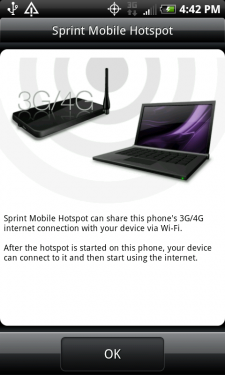
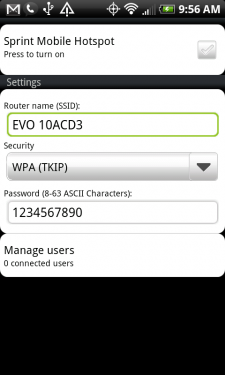
Setup is extremely easy. Launch the app, turn on the service and connect whatever device you have to the Evo's WiFi signal. You can change the access point name to whatever you want. For security, there's WEP, WPA (TKIP) and WPA2 (AES) encryption.
As with all things network, speeds will vary depending on where you live, which way the wind is blowing, how many people around you are using the same service, etc. But obviously 4G should be faster than 3G, and that's the direction Sprint's pointing things.
The hotspot feature costs an extra $29 a month.
High-quality YouTube
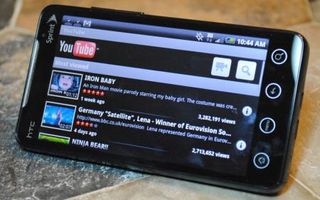
The YouTube application on the Evo plays videos back in high quality, provided you're on 4G or WiFi data. (OK, it actually works on 3G, too, but it's pretty darn slow.) It's a nice addition and looks great on the Evo's screen.
Simultaneous voice and data
The ability to talk on your phone while surfing the web or looking up info has long been a sticking point for Sprint. That's finally changed with the Evo 4G, as you can do both at the same time, so long as you're on WiFi or a 4G connection. We saw it demoed at the launch event in New York.
HDMI output
So there's this little connector on the bottom of the Evo 4G that looks different than the microUSB we're used to. That's because it's a dedicated microHDMI-out connection, allowing you to connect the phone directly to a high-definition television. That makes it easy to show off videos and photos you've taken with the phone. And it also means you can use the phone to show high-definition movies. Not sure exactly how useful that will be in the near-term. Android is still lacking a streamlined ecosystem for purchasing and syncing media, and it becomes even more complicated when you're talking about full feature films, which have rather large file sizes. But for you movie/smartphone buffs out there, it's a nice feature to have.
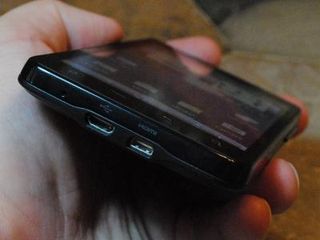
(MicroUSB and micro HDMI connectors on the Evo 4G)
Bad news, though: There's no microHDMI cable included with the Evo, so you're on your own to find one. And do take note that you need a microHDMI cable and not miniHDMI cable (don'tcha just love all these standards?).
The keyboard - typing is a breeze
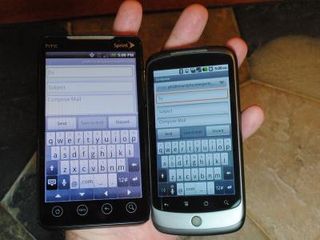
I've been a big fan of HTC's new Android keyboard since I first used it on the Legend, and it's what I use daily on the Nexus One. And I'm an even bigger fan of the keyboard on the Evo's bigger screen. It's ridiculously easy to use. I can fly on this thing. If you're coming from another phone, you'll need to give yourself a couple days to get used to it. But as we so often say: Pixels solve a lot of problems. If you have issues typing on this keyboard, you're just not trying.
Other odds and ends
- Phone calls: Not a problem. Using the Sense dialer is a breeze, and calls were as clear as on any other phone.
- Speakerphone: We're self-professed speakerphone nerds, and the Evo's speakerphone quality is just like the rest of the phone -- big, full and makes us all warm and fuzzy inside. For comparison's sake, it's about as good as the Motorola Droid's, and definitely better than the Nexus One (another HTC phone).
- GPS: Quick and accurate, with Google Maps as well as Sprint Navigation, which uses the Telenav service.
- Non-gmail e-mail: POP3/IMAP and Exchange connect without a hitch. We still recommend using gmail whenever possible, though.
- Sprint apps: Sprint may have lost the NFL to Verizon, but it's been replaced by Sprint Football Live, and it still has the official NASCAR app. There's also Sprint TV and Sprint Zone (account info, etc.).
Conclusion: So it's the biggest - but is it the best?
Larger screen -- love it!
Long before the birth of Android -- way, way back in the dark ages when 320x320 was a big screen -- we would scream from the rooftops that more pixels and larger screens would cure many of our woes. The Evo 4G does that, and then some.
It's fast, and it'll get faster
The 1GHz Snapdragon processor keeps things moving just fine. And the phone will get even quicker once it gets Android 2.2. And while we don't yet have an idea of when it will get the Froyo update, we're as sure as we can be that it will get the update.
HTC's Sense interface
If you're looking at the Evo 4G as your first smartphone, you're making a good choice. HTC's Sense user interface makes things easy out of the box, and there's plenty of room for customization.
Gaming and everyday tasks are easier
So who should look at getting the Sprint Evo 4G? If you're a gamer, it's a no-brainer. I've been bouncing between the same games on the Nexus One and the Evo 4G, and they're much more fun to play on the larger screen. But the same goes for everyday tasks such as e-mail and calendar management. (See how we keep going back to the screen size?)
Sprint's data service
We hesitate to throw out too many overarching statements here. For many people, Sprint's 3G service is great. For others, not so much. We say pick your carrier first, and then your phone, and that still rings true. But Sprint is the first major carrier to get a 4G network up and running. And while the jury's still out on exactly how much (if any) faster WiMax is in its infancy, speeds are only going to go up.
What's the Evo cost?
The Evo 4G will set you back $199.99 after two-year contract extension and $100 rebate (so you'll be paying $300 up front). The Simply Everything plan starts at $69.99, and there's the $10 Premium Data add-on, too. If you want the WiFi hotspot, that's another $29 a month.
So the battery life is just OK ...
Look, it's not great. You're going to have to charge the thing at some point in the day, most likely. Or maybe not. You may well use your phone differently than we do. Moreover, aside from the Windows Mobile-based T-Mobile HD2, nobody's used a phone this large for any length of time, so it's going to take a little time to settle in. Would the battery life keep me from buying this phone? Absolutely not. The other features far outweigh this little niggle.
And maybe the phone's a little too large for some ...
Let's not kid ourselves: While the phone does fit into pockets just fine, it's still a bit of a hoss. And it's going to be a bit big for some people. And if you have small hands, thumbing the corners of the screen could be a stretch. But, again, going about our business on the Evo 4G is much easier and more enjoyable thanks to its size. Period.
We get it -- so is it the best, or not?
Right now? Yes. It's at the top of the Android smartphone pile, for the moment. That's not to say that phones like the HTC Incredible and Nexus One (and very possibly the Samsung Galaxy S) aren't right up there. But the screen size, 4G data and promise of an upgrade to Android 2.2 make the Sprint Evo 4G the phone to beat, and it may well hold that title through the end of 2010.
